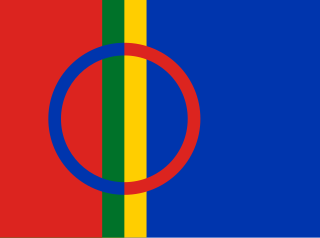
The Sámi are the traditionally Sámi-speaking Indigenous peoples inhabiting the region of Sápmi, which today encompasses large northern parts of Norway, Sweden, Finland, and of the Kola Peninsula in Russia. The region of Sápmi was formerly known as Lapland, and the Sámi have historically been known in English as Lapps or Laplanders, but these terms are regarded as offensive by the Sámi, who prefer their own endonym, e.g. Northern Sámi Sápmi. Their traditional languages are the Sámi languages, which are classified as a branch of the Uralic language family.

Sápmi is the cultural region traditionally inhabited by the Sámi people. Sápmi includes the northern parts of Fennoscandia, also known as the "Cap of the North".

Rovaniemi is a city in Finland and the regional capital of Lapland. It is located near the Arctic Circle in the northern interior of the country. The population of Rovaniemi is approximately 65,000, while the sub-region has a population of approximately 69,000. It is the 17th most populous municipality in Finland, and the 12th most populous urban area in the country. Rovaniemi is also the largest city in Europe by land area.

The Barents Region is a name given, by advocates of establishing international cooperation after the fall of the Soviet Union, to the land along the coast of the Barents Sea, from Nordland county in Norway to the Kola Peninsula in Russia and beyond all the way to the Ural Mountains and Novaya Zemlya, and south to the Gulf of Bothnia of the Baltic Sea and the great lakes Ladoga and Onega. Among the projects is the Barents Road from Bodø in Norway through Haparanda in Sweden and Finland to Murmansk in Russia. The region has six million inhabitants on 1.75 million km2; three quarters of both belong to Russia.

Kirkenes, Girkonjárga (Northern Sami; pronounced[ˈkir̥ː.ko.ˌɲaːrːka], or Kirkkoniemi is a town in Sør-Varanger Municipality in Finnmark county, in the far northeastern part of Norway. The town lies on a peninsula along the Bøkfjorden, an arm of the large Varangerfjorden, and is located just a few kilometres from the Norway–Russia border.
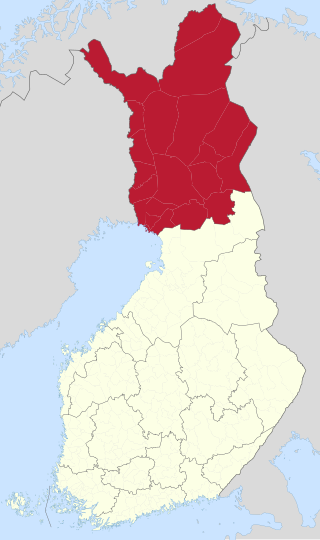
Lapland is the largest and northernmost region of Finland. The 21 municipalities in the region cooperate in a Regional Council. Lapland borders the Finnish region of North Ostrobothnia in the south. It also borders the Gulf of Bothnia, Norrbotten County in Sweden, Finnmark County and Troms County in Norway, and Murmansk Oblast and the Republic of Karelia in Russia. The topography of Lapland varies from vast mires and forests in the south to fells in the north. The Arctic Circle crosses Lapland, so polar phenomena such as the midnight sun and polar night can be viewed in this region.

The Kola Peninsula is a peninsula located mostly in northwest Russia and partly in Finland and Norway. It is one of the largest peninsulas of Europe. Constituting the bulk of the territory of Murmansk Oblast, it lies almost completely inside the Arctic Circle and is bordered by the Barents Sea to the north and by the White Sea to the east and southeast. The city of Murmansk, the most populous settlement on the peninsula, has a population of roughly 270,000 residents.

The Norwegian railway system comprises 4,109 km of 1,435 mm track of which 2,644 km is electrified and 274 km double track. There are 697 tunnels and 2,760 bridges.

Enontekiö is a municipality in the Finnish part of Lapland with approximately 1,800 inhabitants. It is situated in the outermost northwest of the country and occupies a large and very sparsely populated area of about 8,400 square kilometres (3,200 sq mi) between the Swedish and Norwegian border. Finland's highest point, the Halti fell, with a height of 1,324 metres (4,344 ft) above the mean sea level, is situated in the north of Enontekiö. The municipality shares borders with regions of Sweden and Norway that encompass the Scandinavian Mountains. The administrative centre of Enontekiö is the village of Hetta. About one fifth of the community's population are Sami people. Enontekiö's main industries are tourism and reindeer husbandry.

Kemi is a town and municipality of Finland. It is located very near the city of Tornio and the Swedish border. The distance to Oulu is 105 kilometres (65 mi) to the south and to Rovaniemi is 117 kilometres (73 mi) to the northeast. It was founded in 1869 by a decree of the Emperor Alexander II of Russia because of its proximity to a deepwater port.
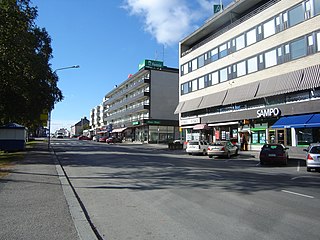
Tornio is a city and municipality in Lapland, Finland. The city forms a cross-border twin city together with Haparanda on the Swedish side. The municipality covers an area of 1,348.83 square kilometres (520.79 sq mi), of which 161.59 km2 (62.39 sq mi) is water. The population density is 17.67 inhabitants per square kilometre (45.8/sq mi), with a total population of 21,002.

A siida is an organisation of humans traditionally present in Sámi societies consisting of several families of reindeer herders whose reindeer graze together. Siidas traditionally encompassed more resources than reindeer, but after changes in Sámi societies over the course of the 1600s, only reindeer herders still practiced this system. It is termed a sameby in Swedish law, reinbeitedistrikt in Norwegian law, and paliskunta in Finnish law. The pastoralist organisation differs slightly between countries, except in Russia, where kolkhoz replaced these earlier organisations.

The Finnish railway network consists of a total track length of 9,216 km (5,727 mi). The railways are built with a broad 1,524 mm track gauge, of which 3,249 km (2,019 mi) is electrified. Passenger trains are operated by the state-owned enterprise VR that runs services on 7,225 km (4,489 mi) of track. These services cover all major cities and many rural areas, though the coverage is less than the coverage provided by the bus services. Most passenger train services originate or terminate at Helsinki Central railway station, and a large proportion of the passenger rail network radiates out of Helsinki. VR also operates freight services. Maintenance and construction of the railway network itself is the responsibility of the Finnish Rail Administration, which is a part of the Finnish Transport Agency. The network consists of six areal centres, that manage the use and maintenance of the routes in co-operation. Cargo yards and large stations may have their own signalling systems.
The Northern East West Freight Corridor, usually referred to as the N.E.W. Corridor, is a project organized by the International Union of Railways UIC and Transportutvikling AS to connect the East Coast of the United States to East Asia by rail and maritime routes.
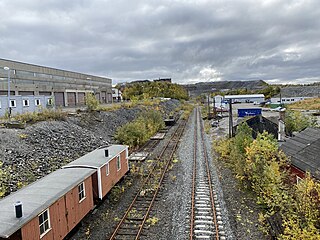
The Kirkenes–Bjørnevatn Line, or the Sydvaranger Line, is a 8.5-kilometer (5.3 mi) long railway line between Kirkenes and Bjørnevatn in Sør-Varanger Municipality, Norway. Owned by the private mining company Northern Iron, the single-track railway is solely used to haul 20 daily iron ore trains from Bjørnevatn Mine to the port at Kirkenes. It was the world's northernmost railway until 2010, when the Obskaya–Bovanenkovo Line in Russia went further north.

Liinakhamari is an ice-free harbour and a rural locality in Pechengsky District of Murmansk Oblast, Russia. The harbour belonged to Finland from 1920 until 1944 when it was ceded to the Soviet Union.

During World War II, the Lapland War saw fighting between Finland and Nazi Germany – effectively from September to November 1944 – in Finland's northernmost region, Lapland. Though the Finns and the Germans had been fighting together against the Soviet Union since 1941 during the Continuation War (1941–1944), peace negotiations between the Finnish government and the Allies of World War II had been conducted intermittently during 1943–1944, but no agreement had been reached. The Moscow Armistice, signed on 19 September 1944, demanded that Finland break diplomatic ties with Germany and expel or disarm any German soldiers remaining in Finland.

The border between Norway and Russia consists of a 195.7-kilometer (121.6 mi) land border between Sør-Varanger Municipality, Norway, and Pechengsky District, Russia, and a 23.2-kilometer (14.4 mi) marine border in the Varangerfjord. It further consists of a border between the two countries' exclusive economic zones (EEZ) in the Barents Sea and the Arctic Ocean. Between 1944 and 1991 the border was between Norway and the Soviet Union. There is a single border crossing, on E105, located at Storskog in Norway and Borisoglebsky in Russia. The Norwegian side is patrolled by the Garrison of Sør-Varanger and is under the jurisdiction of the Norwegian Border Commissioner, while the Russian side is patrolled by the Border Guard Service of Russia. Two-thirds of the border follows two rivers, the Pasvikelva and Jakobselva.
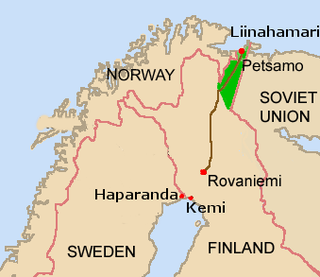
Arctic Ocean Highway was a 531 kilometre-long highway in Lapland, Finland connecting the town of Rovaniemi to the port of Liinakhamari by the Pechenga Bay of the Barents Sea. It was opened in 1931 as the first highway in the world reaching the Arctic Ocean.
Valentina Vyacheslavovna Sovkina is a Russian-Sami politician and chair of the Kola Sámi Assembly.

















